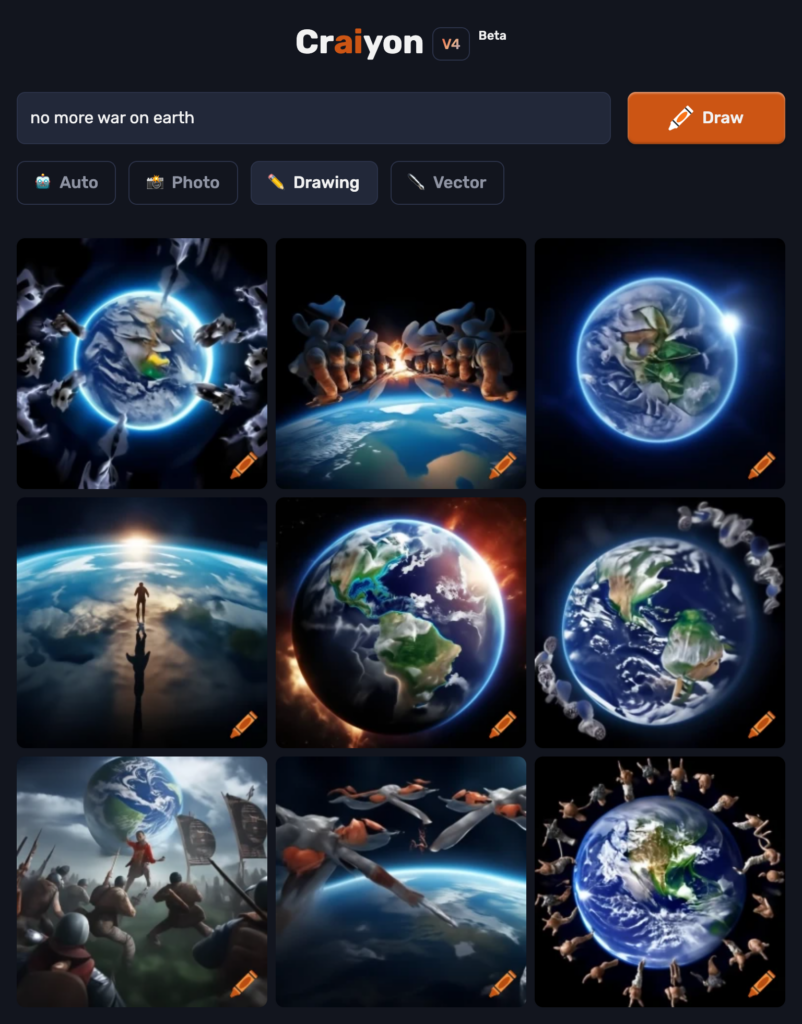Craiyon
I explored Craiyon this week. After trying out about 50 prompts, I have to say I didn’t enjoy the experience at all. AI is always going to be AI, especially when it comes to tasks involving creativity. It might be that Craiyon is still being updated and has a lot to learn, but it seems to lack logic and reasoning.

I admit that my initial prompts were abstract and conceptual, such as “no more war on Earth” and “a four-dimensional world”—concepts that even humans might struggle to visualise. Therefore, I decided to make my prompts more specific.

However, after I changed the mode from Auto to Photo…

What I don’t like the most, aside its absurdity, is that the images lack well-defined and clear lines, making the overall composition feel somewhat blurry and imprecise. This is not only a problem with Craiyon, but with most AI image generators, making it easy for people to identify AI generated image immediately.
I feel that the blurred outlines in these AI-generated images don’t just affect the visuals; they also blur the lines between human and AI-created works. Who has the copyright for these creations—the user, the AI company, or the AI itself? Does AI even have the right to claim ownership of its productions? I’m starting to understand where the inspiration of human-versus-robot war movies come from. While I can’t answer these questions, much like the ongoing legal battle between The New York Times and OpenAI, the moral and legal boundaries surrounding AI are still being debated and will likely take years to resolve. But one thing I’m sure about is that AI will never be able to fully replace humans when it comes to creating art.
Some people call these images “AI art,” but I disagree. According to Merriam-Webster, art is the conscious use of skill and creative imagination, especially in creating aesthetic objects. What I saw on Craiyon lacked both creativity and imagination. It just generates pictures based on the prompts and what it learned from the database, it doesn’t know anything beyond those limits. There’s no emotion or thoughts behind the images.
When I walk into a gallery, I feel the passion, the history, the space. I lose myself in the details of every stroke. Whereas I only see objects in AI-generated images, nothing more. They are and should only be called “AI-generated images.” They have nothing to do with real art. They might be helpful for pitching ideas in a presentation, but if anyone ever decides to hold an exhibition on “AI art”, it would be ridiculous.
Hello, Bifei
I agree with you very much, in the series of images you show generated by Craiyon, these images are indeed too rough and a few are even very incongruous in the cue “no more war on earth”. While it’s true that they don’t qualify as art at all, I’m not sure that the line between AI-generated art and human art is going to blur as time goes on, and that’s something we can keep an eye on in the future. Then I agree with the Pearson MyLab Math SAMR analysis you generated using chatgpt, as well as the issues you raised that weren’t mentioned in the gpt generation. But what we need to analyze is a generative AI tool, and Pearson MyLab Math is an online course platform. I’m not sure if this is the right way to write it. But I think you’ve done a good job with this post. But try to add a couple of prompts from the reflection.
Best regards,
Shiyu
Hi Bifei,
This is a really well-written blog. I enjoyed reading it very much. I have the same view on art as you do. I don’t think AI generated art could classify as art because there’s no emotions or no ideologies that I can see in those arts. Human art, however, has meaning. Isn’t the beauty of art is that we can communicate with the artists?
Your documentation of ChatGPT’s SAMR analysis on MyLab Math makes me wonder if ChatGPT is really “making things up”. It reminds me when I can’t answer a teacher’s question, then I just say something completely off topic to show I am listening to the class. ChatGPT is just like that. For example, you said you never experienced certain feature in MyLab Math that ChatGPT mentioned, I believe ChatGPT invented that feature itself.
Overall, your post allow me to see that ChatGPT is not a very reliable tool for us to gain information. It certainly has values to it, but how much value might depend on how well we know to make the best out of it. This requires a learning process of using AI properly.